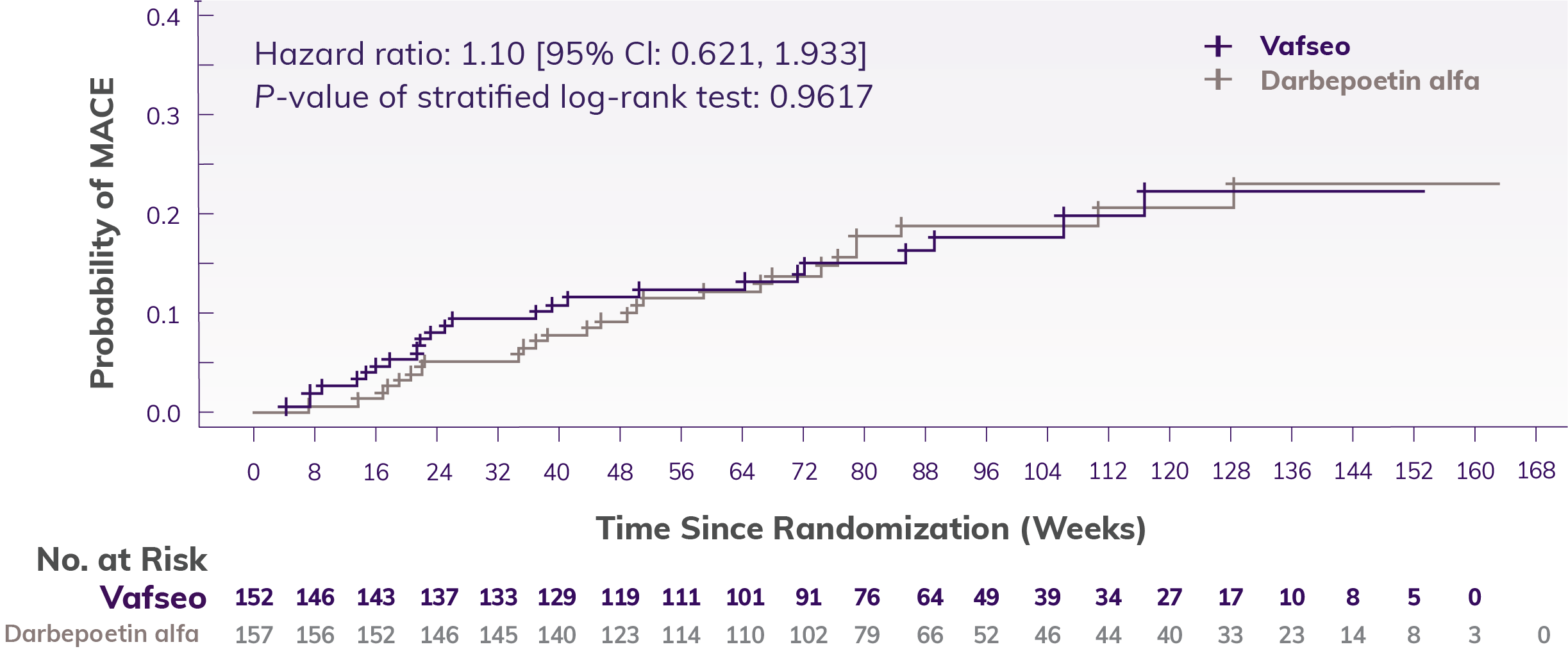For US Healthcare Professionals Only
Prescribing Information& Medication Guide Patient Site
Subgroup analysis of dialysis-dependent CKD patients receiving peritoneal dialysis at baseline1
Subgroup analyses1,2:
Data from the two Phase 3, pivotal trials in a subgroup of patients on peritoneal dialysis compared Vafseo (n=152) and darbepoetin alfa
(n=157) for efficacy (mean change in Hb from baseline to the primary evaluation period of weeks 24-36 and secondary evaluation period of
weeks 40-52) and safety (MACE).* Patients were randomized 1:1 to receive Vafseo with a starting dose of 300 mg once daily or darbepoetin
alfa per prescribing information. Dosing in each treatment arm followed the protocol-specified dose-adjustment algorithm to achieve and
sustain target Hb levels within 10 to 11 g/dL (US) or 10 to 12 g/dL (outside of the US).
The subgroup analyses shown are not contained in the Vafseo product labeling.
Data limitations1:
- Subgroup analyses were conducted post hoc with the exception of time to first MACE, which was prespecified
- Dialysis type was not a stratification factor, leading to an imbalance in patients between regions that have differing Hb treatment targets, which could have influenced results
- All analyses are presented for descriptive purposes only and should be interpreted with caution
- Subgroup analyses were not powered to show differences between treatment arms
The efficacy of Vafseo in adult patients receiving peritoneal dialysis was similar to that observed in the overall dialysis population in the pivotal trials1
LS mean difference in change of Hb from baseline was -0.10 g/dL [95% CI: -0.33, 0.12] and -0.19 g/dL [95% CI: -0.43, 0.05] during primary (Weeks 24-36) and secondary (Weeks 40-52) evaluation periods, respectively.1
Post hoc analysis in patients on peritoneal dialysis:
mean Hb levels over time in the randomized population1


TAP TO EXPAND
ROTATE DEVICE FOR LARGEST VIEW
Mean Hb increased from 10.1 and 10.0 g/dL at baseline to 10.6 and 10.5 g/dL at week 52 in the Vafseo and darbepoetin alfa groups, respectively.1
CI=confidence interval; CKD=chronic kidney disease; Hb=hemoglobin; LS=least squares; SD=standard deviation.
Time to first MACE in adults receiving peritoneal dialysis1,2
The prespecified primary safety endpoint—time to first MACE†—was assessed in a prespecified subgroup of patients receiving peritoneal dialysis.1
Prespecified subgroup analysis in patients on peritoneal dialysis:
Kaplan-Meier curve of time to first MACE1


TAP TO EXPAND
ROTATE DEVICE FOR LARGEST VIEW
Limitations: There was insufficient
statistical power to evaluate differences in
MACE outcomes due to the small sample
size and number of events compared with
the overall pivotal trial population.1
In the peritoneal dialysis patient group,
those receiving Vafseo were less likely to
have cardiovascular disease at baseline
than those receiving darbepoetin alfa.1
Select adverse events1,‡
| Vafseo (N=152) | Darbepoetin alfa (N=157) | |
|---|---|---|
| Treatment-emergent adverse events (TEAEs), n (%) | 134 (88.2) | 150 (95.5) |
| Serious TEAEs, n (%) | 80 (52.6) | 115 (73.2) |
| TEAEs leading to trial treatment discontinuation, n (%) | 6 (3.9) | 5 (3.2) |
| TEAEs leading to death, n (%) | 16 (10.5) | 19 (12.1) |
| All deaths, n (%) | 16 (10.5) | 20 (12.7) |
| TEAEs occurring in ≥10% of patients | ||
| Peritonitis, n (%) | 27 (17.8) | 43 (27.4) |
| Hypertension, n (%) | 22 (14.5) | 30 (19.1) |
| Nasopharyngitis, n (%) | 21 (13.8) | 20 (12.7) |
| Pneumonia, n (%) | 18 (11.8) | 17 (10.8) |
| Asthenia, n (%) | 16 (10.5) | 7 (4.5) |
| Hyperkalemia, n (%) | 9 (5.9) | 22 (14.0) |
| TEAEs occurring in ≥10% of patients | Vafseo (N=152) | Darbepoetin alfa (N=157) |
|---|---|---|
| Peritonitis, n (%) | 27 (17.8) | 43 (27.4) |
| Hypertension, n (%) | 22 (14.5) | 30 (19.1) |
| Nasopharyngitis, n (%) | 21 (13.8) | 20 (12.7) |
| Pneumonia, n (%) | 18 (11.8) | 17 (10.8) |
| Asthenia, n (%) | 16 (10.5) | 7 (4.5) |
| Hyperkalemia, n (%) | 9 (5.9) | 22 (14.0) |
Limitations: Potential bias in reporting adverse events from open-label treatment may occur.1
Dose modifications based on Hb assessment4
| Primary Evaluation Period (Weeks 24-36) | ||
|---|---|---|
| Vafseo (N=152) | Darbepoetin alfa (N=157) | |
| Patients with a dose modification, n (%)# | 123 (80.9) | 141 (89.8) |
| Increased or decreased based on Hb assessment, n (%) | 46 (37.4) | 89 (63.1) |
| Interrupted due to elevated Hb, n (%) | 21 (17.1) | 42 (29.8) |
| Interrupted due to ESA** rescue, n (%) | 12 (9.8) | 1 (0.7) |
Meet Valerie, a 54-year-old patient with anemia due to CKD who has been undergoing at-home peritoneal dialysis for 6 months and must travel to the clinic to receive an ESA to manage her anemia
“With the constant travel and time off work for treatment, managing my anemia has been challenging.”

9.6 g/dL
Transferrin saturation=29% Serum ferritin=448 ng/mL
for her IV iron
Hypothetical patient profile. Not an actual patient.
CKD=chronic kidney disease; ESA=erythropoiesis-stimulating agent; Hb=hemoglobin; IV=intravenous.

WARNING: INCREASED RISK OF DEATH, MYOCARDIAL INFARCTION, STROKE, VENOUS
THROMBOEMBOLISM, and THROMBOSIS OF VASCULAR ACCESS.
VAFSEO increases the risk of thrombotic vascular events, including major adverse cardiovascular events (MACE).
Targeting a hemoglobin level greater than 11 g/dL is expected to further increase the risk of death and arterial and venous thrombotic events, as occurs with erythropoietin stimulating agents (ESAs), which also increase erythropoietin levels.
No trial has identified a hemoglobin target level, dose of VAFSEO, or dosing strategy that does not increase these risks.
Use the lowest dose of VAFSEO sufficient to reduce the need for red blood cell transfusions.
CONTRAINDICATIONS
- Known hypersensitivity to VAFSEO or any of its components
- Uncontrolled hypertension
WARNINGS AND PRECAUTIONS
- Increased Risk of Death, Myocardial Infarction (MI), Stroke, Venous Thromboembolism, and Thrombosis of Vascular AccessA rise in hemoglobin (Hb) levels greater than 1 g/dL over 2 weeks can increase these risks. Avoid in patients with a history of MI, cerebrovascular event, or acute coronary syndrome within the 3 months prior to starting VAFSEO. Targeting a Hb level of greater than 11 g/dL is expected to further increase the risk of death and arterial and venous thrombotic events. Use the lowest effective dose to reduce the need for red blood cell (RBC) transfusions. Adhere to dosing and Hb monitoring recommendations to avoid excessive erythropoiesis.
- HepatotoxicityHepatocellular injury attributed to VAFSEO was reported in less than 1% of patients, including one severe case with jaundice. Elevated serum ALT, AST, and bilirubin levels were observed in 1.8%, 1.8%, and 0.3% of CKD patients treated with VAFSEO, respectively. Measure ALT, AST, and bilirubin before treatment and monthly for the first 6 months, then as clinically indicated. Discontinue VAFSEO if ALT or AST is persistently elevated or accompanied by elevated bilirubin. Not recommended in patients with cirrhosis or active, acute liver disease.
- HypertensionWorsening of hypertension was reported in 14% of VAFSEO and 17% of darbepoetin alfa patients. Serious worsening of hypertension was reported in 2.7% of VAFSEO and 3% of darbepoetin alfa patients. Cases of hypertensive crisis, including hypertensive encephalopathy and seizures, have also been reported in patients receiving VAFSEO. Monitor blood pressure. Adjust anti-hypertensive therapy as needed.
- SeizuresSeizures occurred in 1.6% of VAFSEO and 1.6% of darbepoetin alfa patients. Monitor for new-onset seizures, premonitory symptoms, or change in seizure frequency.
- Gastrointestinal (GI) ErosionGastric or esophageal erosions occurred in 6.4% of VAFSEO and 5.3% of darbepoetin alfa patients. Serious GI erosions, including GI bleeding and the need for RBC transfusions, were reported in 3.4% of VAFSEO and 3.3% of darbepoetin alfa patients. Consider this risk in patients at increased risk of GI erosion. Advise patients about signs of erosions and GI bleeding and urge them to seek prompt medical care if present.
- Serious Adverse Reactions in Patients with Anemia Due to CKD and Not on DialysisThe safety of VAFSEO has not been established for the treatment of anemia due to CKD in adults not on dialysis and its use is not recommended in this setting. In large clinical trials in adults with anemia of CKD who were not on dialysis, an increased risk of mortality, stroke, MI, serious acute kidney injury, serious hepatic injury, and serious GI erosions was observed in patients treated with VAFSEO compared to darbepoetin alfa.
- MalignancyVAFSEO has not been studied and is not recommended in patients with active malignancies. Malignancies were observed in 2.2% of VAFSEO and 3.0% of darbepoetin alfa patients. No evidence of increased carcinogenicity was observed in animal studies.
ADVERSE REACTIONS
- The most common adverse reactions (occurring at ≥ 10%) were hypertension and diarrhea.
DRUG INTERACTIONS
- Iron supplements and iron-containing phosphate binders: Administer VAFSEO at least 1 hour before products containing iron.
- Non-iron-containing phosphate binders: Administer VAFSEO at least 1 hour before or 2 hours after non-iron-containing phosphate binders.
- BCRP substrates: Monitor for signs of substrate adverse reactions and consider dose reduction.
- Statins: Monitor for statin-related adverse reactions. Limit the daily dose of simvastatin to 20 mg and rosuvastatin to 5 mg.
USE IN SPECIFIC POPULATIONS
- Pregnancy: May cause fetal harm.
- Lactation: Breastfeeding not recommended until two days after the final dose.
- Hepatic Impairment: Not recommended in patients with cirrhosis or active, acute liver disease
VAFSEO is indicated for the treatment of anemia due to chronic kidney disease (CKD) in adults who have been receiving dialysis for at least three months.
Limitations of Use
- VAFSEO has not been shown to improve quality of life, fatigue, or patient well-being.
- VAFSEO is not indicated for use:
- As a substitute for red blood cell transfusions in patients who require immediate correction of anemia.
- In patients with anemia due to CKD not on dialysis.
Please note that this information is not comprehensive. Please click here for the Full Prescribing Information, including BOXED WARNING and Medication Guide.